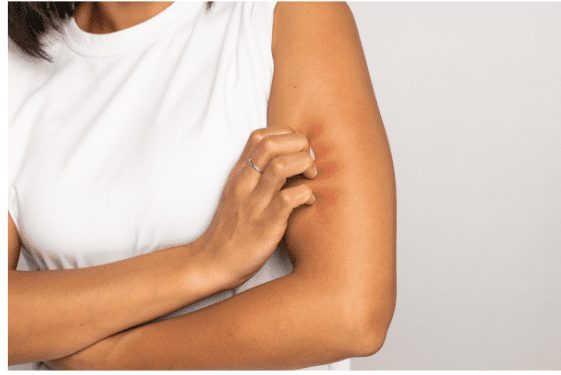Much has been said about the possible harmful effects of chemicals and other additives to foods. More prevalent in our environment, however, and much more annoying, are thousands of skin irritants that give rise to the medical condition known as contact dermatitis.
Dermatitis is inflammation or irritation of the skin. This is often manifested by redness, itching, scaliness and bumps on the skin. Contact dermatitis is a type of allergy.
As with other forms of allergy, discovering the cause of the problem may be easy or may involve a costly and time-consuming allergic work-up.
There are thousands of causes of contact dermatitis, but this discussion will be limited to describing clothing and cosmetics as causative factors. If a person can identify and eliminate the cause of the dermatitis, much time, energy and money can be spared.
The following describes specific body areas and agents associated with contact dermatitis in these regions:
- Scalp and forehead: Common offenders are hair dyes and bleaches. Hairnets, bathing caps, hats, etc. can produce a typical “band” pattern on the forehead.
- Eyelids: This sensitive area reacts to eye makeup, perfume, nail polish and anything else on the hands that comes in contact with the lids.
- Ears: If on the external ear, suspect hair dyes, shampoos and sprays. If on the back of the ear, think about eyeglass frames. At the opening of the canal, earplugs can be an offender. On the ear lobes, nickel sensitivity from earrings is a major cause. The offending jewelry can be worn after covering it with several layers of clear nail polish.
- Face: Almost anything can cause dermatitis, as hands touch your face dozens of times a day. Shaving lotion, powder, cosmetics, flowers, stuffed animals and poison ivy are some of the diverse irritants.
- Lips: New lipstick takes about a week to sensitize the individual but old lipstick can become sensitizing. Other materials are toothpaste, citrus, fruits, musical instruments, pins (such as bobby pins held in the mouth) and pens, etc.
- Neck: This area is prone to dermatitis from hair preparations and dyes. The back of the neck can be affected by jewelry clasps or dress fasteners. A collar-like rash can be due to necklaces or the coloring from a new garment.
- Armpit: Deodorants and perfumes are common offenders.
- Trunk: Affected areas include the breast area from rubber in bra contact; girdle area from rubber; waist or belt area from rubber, tanning agents or products from bathtub mats. Other general rashes can come from perfumes or soap.
- Genital area: Possible causes are chemicals on toilet seats, scented toilet paper, condoms, douches, perfumes, and feminine hygiene deodorant sprays.
- Extremities: Hands and feet come in contact with hundreds of items daily. Nickel and rubber are common offending agents. Wrist or watch bands, gloves, jewelry, socks, shoes and sandals, if they contain noxious agents, leave a characteristic pattern in the involved area.
The cure for all contact dermatitis is removal of the offending substance. Immediate medical relief can be obtained with “over-the-counter” cortisone preparations and/or calamine lotion. Contact dermatitis that is long-standing, however, should be treated by a physician to prevent serious permanent consequences such as scarring.






